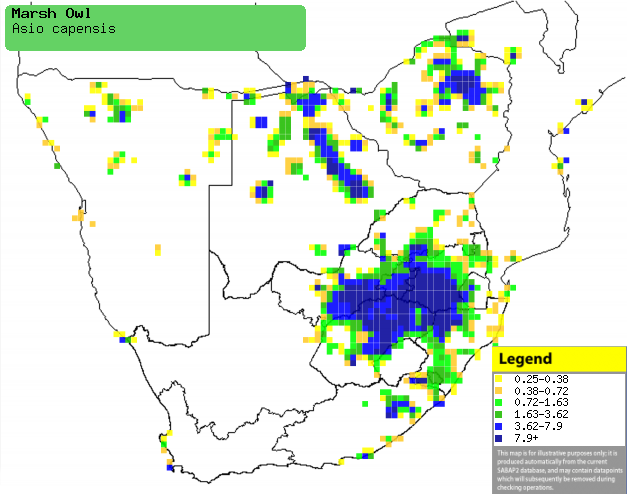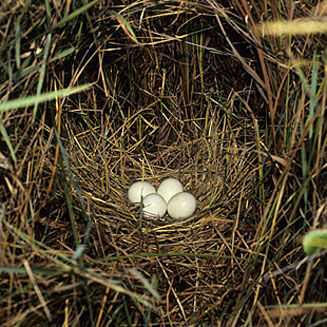|
Asio capensis (Marsh owl)
Vlei-uil [Afrikaans]; iNkovane, umShwelele [Zulu]; Kakuru
(also applied to other owl species) [Kwangali]; Sephooko (also applied to Barn
owl and African grass-owl) [South Sotho]; Zizi (generic name for owl) [Shona];
Xikhotlwana (also applied to African scops-owl) [Tsonga]; Lerubise (also applied
to African grass-owl and Barn owl) [Tswana]; Afrikaanse velduil [Dutch]; Hibou
du Cap [French]; Kapohreule [German]; Coruja-dos-pāntanos [Portuguese]
Life
> Eukaryotes >
Opisthokonta
> Metazoa (animals) >
Bilateria >
Deuterostomia > Chordata >
Craniata > Vertebrata (vertebrates) > Gnathostomata (jawed
vertebrates) > Teleostomi (teleost fish) > Osteichthyes (bony fish) > Class:
Sarcopterygii (lobe-finned
fish) > Stegocephalia (terrestrial
vertebrates) > Tetrapoda
(four-legged vertebrates) > Reptiliomorpha > Amniota >
Reptilia (reptiles) >
Romeriida > Diapsida > Archosauromorpha > Archosauria >
Dinosauria
(dinosaurs) > Saurischia > Theropoda (bipedal predatory dinosaurs) >
Coelurosauria > Maniraptora > Aves
(birds) >
Order: Strigiformes
> Family: Strigidae
The Marsh owl has populations scattered across Botswana,
Zimbabwe and large areas of South Africa, living mainly in tall grassland. It
usually hunts in the day, eating insects but also small vertebrates, mainly
hunting on the wing. It usually nests in a slight depression in the ground,
surrounded by dense grass and weeds, making it difficult to find. Here it lays
2-6, usually 2-4 eggs, which are incubated solely by the female, for about 27-28
days. The male does all the hunting, storing his prey in "caches", to be eaten
later by either him or the female. The chicks stay in the nest for about 14-18
days, after which they crawl around the surrounding bush for a few weeks, at
least until they learn to fly, becoming independent about a month later.
Distribution and habitat
Occurs from Ethiopia to southern
Africa, where it is uncommon to locally common in northern Namibia, northern and
central Botswana, Zimbabwe, Mozambique and east-central South Africa. As it name
suggests it generally prefers marshes, however it also occupies tall
grassland, reeds, sedges and Acacia woodland.
|
 |
|
Distribution of Marsh owl in southern Africa,
based on statistical smoothing of the records from first SA Bird Atlas
Project (©
Animal Demography unit, University of
Cape Town; smoothing by Birgit Erni and Francesca Little). Colours range
from dark blue (most common) through to yellow (least common).
See here for the latest distribution
from the SABAP2. |
Predators and parasites
Food
Usually hunts in the day, eating insects but
also small vertebrates. When hunting, it flies low over the ground, searching
for prey and occasionally swerving or hovering. Once a prey item has been spotted
it rapidly dives to the ground, picking it up with its talons before storing it
in a nearby hiding place to be eaten later. The following food items have been
recorded in its diet:
- Invertebrates
- Vertebrates
Breeding
- It nests in a slight depression in the ground, concealed in dense grass and weeds.
 |
|
|
Marsh owl nest with eggs, Sericea farm,
South Africa. [photo Warwick Tarboton ©] |
|
- Egg-laying season is from October-December in Botswana, and mainly from
March-April elsewhere in southern Africa.
- It lays 2-6, usually 2-4 eggs, which are incubated solely by the female
for about 27-28 days. The male does all the hunting, storing his prey in
caches to be eaten later by either him or the female.
- The chicks stay in the nest for about 14-18 days, after which they crawl
around the surrounding bush for a few weeks, at least until they learn to
fly. The fledglings are thought to remain dependent on their parents until
they are about 80 days old.
Threats
Not threatened, in fact common in large areas of southern
Africa.
References
-
Hockey PAR, Dean WRJ and Ryan PG (eds) 2005. Roberts
- Birds of southern Africa, VIIth ed. The Trustees of the John Voelcker
Bird Book Fund, Cape Town.
|
